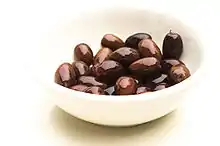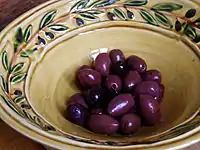Kalamata olive
The Kalamata olive is a large, dark purple olive with a smooth, meaty texture, named after the city of Kalamata in the southern Peloponnese, Greece.[2] Often used as table olives, they are usually preserved in wine vinegar or olive oil. Typically the term "Kalamata" legally refers to a region of Greece where these olives are grown, however a few countries (those mainly outside the United States and European Union) use the name for such olives grown anywhere, even outside of Greece. Within the EU (and other countries that ratified PDO agreements or similar type law) the name is protected with PDO status, which means in the EU the name can only be used for olives (and olive oil) from the Messinia region of Greece.[3] Olives of the same variety grown elsewhere are marketed as Kalamon olives in the EU and, sometimes, elsewhere.[4][5][6][7][8]
| Kalamata | |
|---|---|
 A bowl of Kalamata olives | |
| Olive (Olea europaea) | |
| Color of the ripe fruit | Dark purple |
| Origin | Greece |
| Notable regions | Kalamata |
| Hazards | Verticillium wilt and cold |
| Use | Table and oil |
| Oil content | 6.8% |
| Symmetry | Slightly asymmetrical |
| Nutritional value per 100 g (3.5 oz) | |
|---|---|
| Energy | 284 kJ (68 kcal) |
3g | |
6.8g | |
0g | |
Source:[1] | |
| |
| †Percentages are roughly approximated using US recommendations for adults. | |
Description
Kalamata olives are so-named because they were originally grown in Kalamata in Messinia and also in nearby Laconia, both located on the Peloponnese peninsula. They are now grown in many places around the world, including in the United States and Australia. They are almond-shaped, plump, dark purple olives[9] from a tree distinguished from the common olive by the size of its leaves, which grow to twice the size of other olive varieties.[2] The trees are intolerant of cold and are susceptible to Verticillium wilt but are resistant to olive knot and to the olive fruit fly.[10]
Kalamata olives, which cannot be harvested green, must be hand-picked in order to avoid bruising. They are classed as black olives.
Synonyms
Aetonychalea: (Kalámai), Aetonychi: (Greece), Aetonycholia: (Kalámai and Pátrai), Calamata (Agrínio, Aitolokón, Cyprus, Iznik, Kalámai, Lakonia, Messíni, Pelopónnisos, Spárti, Western Cape, and California,
Calamatatiani (Greece), Calamon: California, Kalámai, Kríti, Lakonia, Lamia, Messíni, Pátrai, Pelopónnisos, and Tunisie, Western Australia, Chondrolia: Kalámai, Lakonia, Messíni, and Pátrai, Kalamata Jumbo and Kalamata Tiny, and Western Australia,
Kalamataiani: Pelopónnisos, Kalamon: Greece, China, Cyprus, Kríti, Pelopónnisos, Perugia (Italy), and South Africa,
Karakolia (Greece), Nychati: Kalámai and Pelopónnisos, Nychati di Kalamata: Aitolokón, Kalámai, and Lakonia, Tsigeli: , and Karamursel Su Kalamata: Bursa, Gebze, Gölcük, Karamürsel, Kocaeli, the Marmara region, and the variety of Su Zeytini of Turkey.[11]
Preparation
There are two methods of preparing Kalamata olives, known as the long and short methods. The short method debitters the olives by packing them in water or weak brine, which is changed daily, for around a week. Once complete, they are then packed in brine and wine vinegar with a layer of olive oil and slices of lemon on top. The olives are often slit to decrease the processing time. The long method involves slitting the olives, placing them in strong brine for up to three months in order to debitter them. Levels of polyphenol remain in the olives after processing, giving them their slightly bitter taste.[12]
Gallery
 Old advertisement for soapmaking
Old advertisement for soapmaking A plate with black Kalamata olives
A plate with black Kalamata olives
References
- "Kalamata Olives". Livestrong.com. Retrieved 21 May 2011.
- Miller, Korina (2010). Greece. Oakland, California: Lonely Planet. p. 218. ISBN 978-1-74179-228-7.
Kalamata olive.
- Quinn, Jennifer (29 July 2004). "Selling porkies - an almighty pie fight". BBC News Online Magazine. Retrieved 21 May 2011.
- "Kalamon and Kalamata Olives – legislation changes the name". Archived from the original on 2014-05-19.
- "On the different varieties of Greek olives".
- "What is the difference between Kalamon olives and Kalamata olives?". Archived from the original on 2017-10-01. Retrieved 2016-05-01.
- "Greek Olive Species".
- "Olive Cultivars of South Africa".
- Antol, Marie Nadine (2004). The Sophisticated Olive: The Complete Guide to Olive Cuisine. Garden City Park, NY: Square One Publishers. pp. 37. ISBN 978-0-7570-0024-9.
Kalamata olive.
- Wiesman, Zeev (2009). Desert Olive Oil Cultivation: Advanced Biotechnologies. New York: Elsevier. p. 147. ISBN 978-0-12-374257-5.
- "General Characters for Cultivar Kalamata".
- Kailis, Stan (2007). Producing Table Olives. Collingwood, Vic.: Landlinks Press. pp. 206–207. ISBN 978-0-643-09203-7.